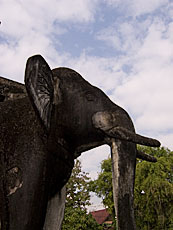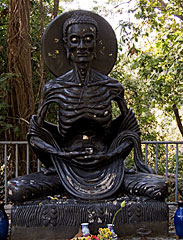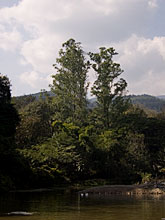You and I Are Disappearing
I had been watching the eastern horizon for what felt like an hour, waiting for some perceptible change that would signal the coming of dawn, but it wasn’t until after the bus stopped and my fellow passengers and I disembarked at the 7-11 next to the truck stop, that I finally noticed a slight glow.
It had been, as Snoopy would say, a dark and stormy night, except that it wasn’t stormy, it was simply dark. I have become completely incapable of sleeping in any sort of moving vehicle. When warping space through movement, time slows down and while this may sound metaphorical given that a bus does not move through space fast enough to actually slow down time, it is not. The two weeks I spent in Bangkok flew by, but when I am moving from place to place time always seems to slow down, and not just the actual traveling time, but all time, even that spent in a restaurant or at night in bed with a book; everything happens slower when you’re traveling.
I bought a bottle of orange juice and sat down on the curb to watch the sunrise, but found my attention drawn instead to a dying moth fluttering about on its back making near perfect circles on the concrete. It continued without rest the entire time I sat there and seemed to me to signify something, though in my foggy sleep-deprived state, I could not say what it was the moth’s movements meant to me, merely that they meant something.
By the time we actually reached Chiang Mai it was well past dawn and the city just beginning to stir. After securing a room and depositing my belonging I considered trying to nap, but in the end decided to explore the town. What better way to see Buddhist temples than in the dreamy fog of sleeplessness? Chiang Mai has over three hundred wats within the somewhat sprawling city limits, most of them reasonablely modern and in my opinion not worth visiting. I narrowed the field to three, which I figured was a nice round one percent.
 The most striking of the three was the oldest, wat Chiang Man from which Chiang Mai takes its name. The main stupha near the rear of the temple compound was a decaying edifice of what appeared to be limestone. The structure was about average in height, that is to say around 30 meters, and near the base a number of carved elephants jutted out. The stone was weathered black and splotchy from various lichens and mosses and of course the rain and pollution. I have no doubt it is earmarked for renovation, but I find that I enjoy crumbling, weather beaten temples more than those that have been carefully restored. Perhaps it is that the wear and tear of ages spent in the tropical sun lends some authenticity of age to stone, a reminder that these structures were around even when my own culture was still wearing its metaphorical diapers. I have always thought of the standard timeline of history as a circle viewed from the side, and from this perspective there is a backside to what we normally think of as the passage of time. Rather than moving forward down a line, events recede and grow closer as they move through time; the weathering of the stone elephants was to me a reminder of this two dimensional movement of time, as if the stone had not only passed along a line, but also moved forward and backward, picking up here and there a spot or streak of rain or growth of moss.
The most striking of the three was the oldest, wat Chiang Man from which Chiang Mai takes its name. The main stupha near the rear of the temple compound was a decaying edifice of what appeared to be limestone. The structure was about average in height, that is to say around 30 meters, and near the base a number of carved elephants jutted out. The stone was weathered black and splotchy from various lichens and mosses and of course the rain and pollution. I have no doubt it is earmarked for renovation, but I find that I enjoy crumbling, weather beaten temples more than those that have been carefully restored. Perhaps it is that the wear and tear of ages spent in the tropical sun lends some authenticity of age to stone, a reminder that these structures were around even when my own culture was still wearing its metaphorical diapers. I have always thought of the standard timeline of history as a circle viewed from the side, and from this perspective there is a backside to what we normally think of as the passage of time. Rather than moving forward down a line, events recede and grow closer as they move through time; the weathering of the stone elephants was to me a reminder of this two dimensional movement of time, as if the stone had not only passed along a line, but also moved forward and backward, picking up here and there a spot or streak of rain or growth of moss.
While all of the wats were interesting in their own way, none compelled me to linger long and, finding myself at loose ends, I decided to ruin my round number and head to one more wat, wat Umong, located just outside the old city. I caught a ride with a songthaew (a truck taxi basically) to the entrance and wandered in. The main appeal of wat Umong was that, unlike the wats in the city, it sprawled out over a large forested hill. The forest reminded me a little of the area around Athens GA, but with no kudzu, a sort of forest I’ve never been able to put my finger on, not true jungle, but with lots of undergrowth and creeping vines crawling up the trunks of hardwood trees, and then broad leafed shrubs with white flowers, and an endless variety of ground cover much of it sprouting small purple flowers, even an orchid or two clinging to the trunk of an oak near the entrance; not what I would call jungle and not what I would call deciduous.
Most wats have a central focal point, some particular image of Buddha or an old temple building or something that creates a locus around which everything else has been constructed, but wat Umong lacked that focal point entirely. Various paved trails took off in all directions and I could see a number of buildings poking their characteristic pointed roofs up into the branches of nearby trees. Toward the back of the wat was a network of tunnels quite obviously dug out by human means. According to the monks I spoke to no one knows who originally dug the caves; the local legend is that a solitary monk came here to meditate and created the place himself.  And though there is no historical evidence to support that story, I couldn’t help but thinking of that solitary and one might think, maybe a little crazy, monk digging these tunnels with his bare hands. Such thoughts made the otherwise rather sterile and plain tunnels invested with an idiosyncratic quality, as if perhaps this fictitious monk were trying to get at some point in the tunnels, not some physical thing, but rather convey some mood or meaning through design alone.
And though there is no historical evidence to support that story, I couldn’t help but thinking of that solitary and one might think, maybe a little crazy, monk digging these tunnels with his bare hands. Such thoughts made the otherwise rather sterile and plain tunnels invested with an idiosyncratic quality, as if perhaps this fictitious monk were trying to get at some point in the tunnels, not some physical thing, but rather convey some mood or meaning through design alone.
Perhaps the reason wat Umong has no centrality is that the main image of Buddha at the wat is rather frightening looking and represents the Buddha at the end of one of his failed early attempts at enlightenment. For those that aren’t familiar with the life of Buddha, Buddha tried unsuccessfully to reach enlightenment through various methods before he found the middle way as it is known. The method represented at wat Umong shows Buddha as an emaciated skeleton at the end of a long period of self-mortification. What was so striking about this statue once one gets past the near skeletal appearance of Buddha were the eyes which seemed to glow with, for lack of a better word, hunger.  But not the calm sort of hunger that one might imagine the Buddha to have, this was more of a ravenous devouring and vaguely frightening hunger. The sort of piercing stare that threatens to engulf you when you step into it.
But not the calm sort of hunger that one might imagine the Buddha to have, this was more of a ravenous devouring and vaguely frightening hunger. The sort of piercing stare that threatens to engulf you when you step into it.
After loitering for a while in the peripherals of Buddha’s famished gaze I made my way down to a small pagoda near the fishpond where, as the sign near the entrance had claimed, there would be an informal discussion on Buddhism with a monk. Several other westerners slowly trickled down as the appointed time arrived, including an older American man I had spoken to earlier. He had asked where I was from and I generally just answer that with the last place I’ve lived, which as it turned out he had also lived in. We spoke for a while of weather and the Red Socks and other things only New Englanders really care about and then I had wandered off to explore.
The session began slowly, no one wanted to ask any questions and my sleep-deprived mind was too slow to formulate anything intelligent enough to say out loud. For their part the monks were perfectly comfortable with the vast periods of silence which I could tell left many of those in attendance feeling a bit awkward. It’s not often you meet people who are comfortable with long periods of silence. Eventually a few questions were voiced, mostly technical things like the difference between how monks practice Buddhism versus what you could call a layperson practices Buddhism, or what the goals of meditation are. I had a number of questions in my mind by then, but for some reason found myself unwilling to ask them. Part of me suspected that perhaps I did not really want to know the answers as the more I learn of Buddhism, the less I agree with it.
No matter where the questions began, in the course of his response the monk kept coming back to the phrase “cause and effect,” which in his pronunciation sounded more like “cause and affect.” This slight semantic difference became somehow telling to me the more he repeated it, as if his own language were betraying him. I have struggled to understand Buddhism as it is practiced in Thailand since I arrived. Much of what I have seen at wats has been out of line with what I know of the Buddha’s teachings and indeed the monks confirmed that as with any religion, many of those who follow Buddhism do not really practice what the Buddha taught. The chief thing the monk seemed concerned with was the relationship between the causes of action and effect of those actions. But his, and perhaps Buddhism’s in general, interpretation of that relationship seemed to me woefully simplified.
I kept wondering what Buddhism would say to a theory like chaos mathematics. I did not ask because really I did not want to know, I prefer to wonder about these sort of things rather than have any definitive answer, assuming a definitive answer to such a nebulous question were even possible. But I failed to see how one could ever really determine a relationship between cause and effect given that the chain of events that follow from any one thought or action are far too wide reaching, complicated and extensive for the human mind to keep track of, and even if we were able to follow the chain clearly, it is unlikely that just because one’s intentions were good, that it necessarily follows that the outcome of those intentions are positive for all that end up being effected by it.
Somewhere in the middle of the talk I realized that, while it may have betrayed my westernness in thinking so, I believe in randomness and ambiguity and patterns so complex as to be indecipherable and to try and find the order and meaning within them is to miss the point of their existence. There is actually a word for this idea, pareidolia, which means simply the fanciful perception of meaning in something that is actually ambiguous, and this is perhaps what troubled me about the monks ideas, not that they were wrong, but that they strove to remove all ambiguity from life. I thought again of the moth fluttering on the concrete; the pattern of his dying arcs could hold some meaning if I chose to attach one to the other, but at the same time, perhaps the deeper meaning lay with my own awareness that I was creating it. That is to say, perhaps the moth was simply dying and any connection beyond that was an act of my imagination, not something inherent in the moth’s death, which isn’t to say that that connection shouldn’t be made, but merely to acknowledge that the connection arose from the imagination.
 Eventually as new people arrived questions and answers began to repeat themselves and as discreetly as possible I slipped away and wandered down to the shores of the pond to watch the cumulous clouds forming over the distant hills. I sat for a while on a small bench near the shore thinking of the clouds and the patterns and shapes we sometimes see in them, which like the moth’s circle are inventions of our mind at play. As I stood to walk home it occurred to me that perhaps that the joy of life is not to puzzle out the connections between things, but to play amongst them and with them.
Eventually as new people arrived questions and answers began to repeat themselves and as discreetly as possible I slipped away and wandered down to the shores of the pond to watch the cumulous clouds forming over the distant hills. I sat for a while on a small bench near the shore thinking of the clouds and the patterns and shapes we sometimes see in them, which like the moth’s circle are inventions of our mind at play. As I stood to walk home it occurred to me that perhaps that the joy of life is not to puzzle out the connections between things, but to play amongst them and with them.
Thoughts?
Please leave a reply:
All comments are moderated, so you won’t see it right away. And please remember Kurt Vonnegut's rule: “god damn it, you’ve got to be kind.” You can use Markdown or HTML to format your comments. The allowed tags are
<b>, <i>, <em>, <strong>, <a>. To create a new paragraph hit return twice.